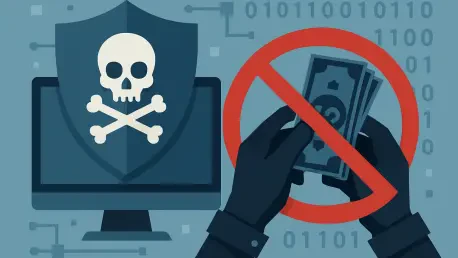The escalating threat of ransomware has pushed the UK government to propose a bold strategy aimed at curbing the financial incentives driving these cyberattacks, with a particular focus on public sector entities. Under this initiative, a ban on ransomware payments is set to be imposed on publicly funded bodies and critical national infrastructure providers, including vital services like the NHS, schools, and local councils. Alongside this, a mandatory pre-payment notification system will apply to private companies, requiring them to report any intention to pay a ransom, even though such payments remain legally permissible for them. This dual approach seeks to disrupt the cybercrime business model by making public institutions less attractive targets. However, while the intent is to safeguard national interests, the ripple effects of these measures could significantly reshape the cybersecurity landscape for private sector businesses. The following sections delve into the potential challenges and strategies for navigating this evolving regulatory framework.
1. Understanding the Proposed Ransomware Payment Ban
The UK government’s plan to ban ransomware payments for public sector organizations marks a significant shift in the fight against cybercrime, targeting entities that are often seen as high-value targets due to their critical role in society. This ban extends to critical national infrastructure providers, such as the NHS, schools, and local councils, aiming to eliminate the financial motivation for attackers by ensuring no ransom is paid. Simultaneously, private companies face a new layer of oversight through a mandatory pre-payment notification regime. While these businesses are not prohibited from making payments, they must inform the government of their intentions, introducing potential delays or interventions. The overarching goal is to reduce the profitability of ransomware attacks on public services, thereby deterring cybercriminals. Yet, this approach raises questions about how the burden of cyberattacks might shift, potentially placing private sector firms under greater scrutiny and risk in an already challenging digital environment.
This proposed legislation, while rooted in a desire to protect national interests, could inadvertently alter the dynamics of cyber threats across different sectors. By removing the option of payment for public entities, the government hopes to send a strong message to attackers that such targets are no longer viable for financial gain. However, this could lead to unforeseen consequences for private businesses, which may become the new focal point for cybercriminals seeking lucrative payouts. The mandatory reporting requirement for private firms adds another layer of complexity, as it places them in a position where government oversight could conflict with urgent business needs during a crisis. The balance between compliance and operational survival becomes a critical concern, especially for organizations lacking robust cybersecurity measures. As these regulations take shape, understanding their scope and implications is essential for businesses to prepare effectively for the changing landscape of ransomware threats and regulatory expectations.
2. Rising Risks for Private Sector Businesses
As the ransomware payment ban makes public sector targets less appealing, there is a growing concern that cybercriminals will pivot their focus toward private sector companies, intensifying the pressure on industries already grappling with digital vulnerabilities. Small and medium-sized enterprises (SMEs), retailers, manufacturers, and non-profits could find themselves in the crosshairs, facing a surge in attacks as criminals seek alternative sources of revenue. These organizations often lack the resources of larger corporations or public entities to invest in comprehensive cybersecurity defenses, making them particularly susceptible to exploitation. The shift in targeting could result in a significant uptick in ransomware incidents, with attackers exploiting weaker security protocols to demand payments. For many private firms, this heightened risk underscores the urgent need to reassess their preparedness and resilience against such threats in a landscape where attackers are increasingly adaptive and relentless.
Beyond the increased likelihood of being targeted, private sector businesses face additional challenges stemming from the mandatory pre-payment notification system, which could complicate their response to ransomware incidents. Companies intending to pay a ransom must notify the government, opening the door to potential intervention or outright blocking of the payment. This creates a profound dilemma for firms whose survival may depend on regaining access to critical systems or data. The risk of legal repercussions or public scrutiny adds further tension, as businesses weigh compliance against operational continuity. Some may even consider making payments discreetly to avoid bankruptcy, undermining the transparency the notification system aims to achieve. Research indicates a stark divide in attitudes, with 94% of UK business leaders supporting the public sector ban, yet 75% admitting they would pay a ransom if it were the only way to save their organization, highlighting a significant compliance gap that could challenge the effectiveness of the proposed measures.
3. Building Cyber Resilience in the Private Sector
Given the mounting ethical, legal, and operational challenges posed by ransomware attacks and the impending regulatory changes, private sector firms must prioritize strengthening their cyber resilience to reduce reliance on paying ransoms. The likelihood of being targeted is growing, especially as public entities become less viable for attackers under the payment ban. Businesses cannot afford to remain reactive, waiting for an incident to occur before taking action. Instead, a proactive approach is necessary, focusing on robust defenses that can prevent attacks or mitigate their impact. This involves investing in advanced security tools, training employees to recognize phishing attempts, and establishing clear incident response protocols. By fortifying their digital infrastructure, companies can better withstand the evolving tactics of cybercriminals and navigate the complexities of compliance with new government mandates without sacrificing operational stability.
Moreover, enhancing cyber resilience requires a cultural shift within organizations to view cybersecurity not as a one-time expense but as an ongoing strategic priority. Regular assessments of vulnerabilities, coupled with updates to security policies, can help identify and address weaknesses before they are exploited. Collaboration with industry peers and cybersecurity experts can also provide valuable insights into emerging threats and best practices for defense. The reality is that paying a ransom offers no guarantee of data recovery and often increases the likelihood of future attacks, as it signals vulnerability to criminals. Therefore, private firms must focus on building systems and processes that minimize the need to consider payment as an option. By embedding resilience into their core operations, businesses can better protect themselves against the financial and reputational damage caused by ransomware, ensuring they are prepared for both current threats and future regulatory demands.
4. Implementing a Business-First Strategy with the Minimum Viability Model
To effectively manage the fallout from a ransomware attack, private sector organizations can adopt the Minimum Viable Company (MVC) model, a pragmatic framework designed to maintain essential operations during a crisis while minimizing disruption. The MVC approach prioritizes the restoration of mission-critical services first, allowing businesses to continue functioning at a basic level until a full recovery is possible. This strategy is particularly beneficial for firms that cannot afford prolonged downtime, as it provides a structured path to stabilize operations. Key steps include identifying fundamental applications and services that must remain operational, such as authentication systems, communication platforms like email, financial tools, and customer-facing applications. By focusing recovery efforts on these core elements, companies can buy crucial time to address broader system restoration without succumbing to the pressure of immediate ransom demands or operational collapse.
Implementing the MVC model also involves specific, actionable measures to ensure readiness and resilience against ransomware threats. Businesses should invest in advanced data protection solutions, such as immutable, air-gapped backups that prevent attackers from altering or deleting critical information. Regular validation of recovery points is essential to confirm that clean data is available for restoration. Additionally, clearly defining the roles and responsibilities of key stakeholders ensures a coordinated response during an incident. Conducting frequent scenario-based recovery drills helps teams prepare for real-world attacks, enabling faster and more effective restoration to a minimum viable state. These exercises also allow organizations to continuously refine their processes, addressing gaps in preparedness. By integrating the MVC framework into their cybersecurity strategies, companies can reduce dependency on ransom payments and maintain critical functionality, even under the strain of an attack or regulatory oversight.
5. Navigating Future Regulatory Changes
As the UK government moves closer to formalizing the ransomware payment ban and mandatory reporting requirements, businesses across both public and private sectors must prepare for the implications of these regulations on their operations. The finalized rules will likely demand greater transparency and accountability, especially for private firms under the notification regime. Companies need to develop clear, actionable plans to restore critical systems, data, and processes following an attack, recognizing that paying a ransom rarely guarantees recovery and often heightens the risk of repeated targeting. Proactive planning is essential to ensure compliance while safeguarding business continuity. This includes mapping out response strategies that align with regulatory expectations and investing in technologies that support rapid recovery. Staying ahead of these changes will be crucial for organizations to avoid penalties and maintain trust with stakeholders in an increasingly regulated environment.
Furthermore, integrating minimum resilience principles into recovery and planning strategies can significantly reduce the risk of complete operational failure during a ransomware incident. Businesses should focus on building frameworks that prioritize the protection and restoration of essential functions, ensuring they can operate at a basic level even under duress. Collaboration with legal and cybersecurity experts can provide guidance on navigating the complexities of reporting requirements and potential government interventions. Regular updates to incident response plans, informed by the latest threat intelligence, will help organizations remain agile in the face of evolving cyber risks. As these regulations take shape, a commitment to resilience and preparedness will empower UK businesses to adapt to new challenges without compromising their core operations, setting a foundation for long-term stability in a landscape where both cyber threats and regulatory oversight are intensifying.
6. Reflecting on Proactive Measures Taken
Looking back, the response to the proposed ransomware payment ban revealed a critical need for UK businesses to have fortified their defenses against the shifting landscape of cyber threats. Many organizations took significant steps to enhance their cybersecurity posture, recognizing that the ban on payments for public entities had redirected attacker focus toward the private sector. The adoption of structured frameworks like the Minimum Viable Company model proved instrumental for numerous firms, as it enabled them to sustain essential operations during attacks without resorting to ransom payments. These efforts underscored the importance of preparation and resilience, demonstrating that a proactive stance had been far more effective than reactive measures in mitigating the impact of ransomware incidents.
Moving forward, the emphasis for UK businesses should be on sustaining and expanding these proactive measures to address future challenges posed by both cybercriminals and regulatory changes. Continued investment in robust data protection, regular training, and scenario-based drills could further strengthen organizational readiness. Collaboration across industries to share insights and strategies might offer additional layers of defense against sophisticated attacks. By building on the lessons learned, companies can position themselves to not only comply with evolving regulations but also to thrive in a digital environment where resilience is paramount. The focus on actionable, forward-thinking solutions will ensure that businesses remain agile and protected against the persistent and ever-evolving threat of ransomware.









